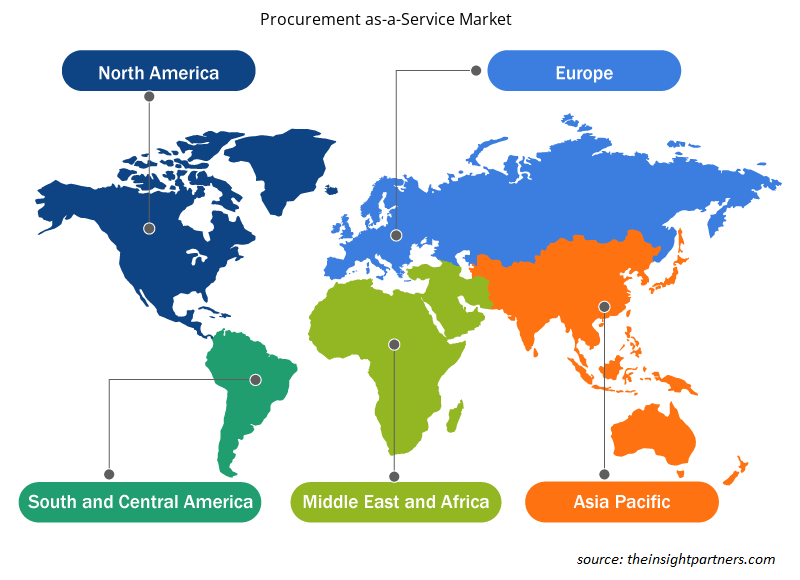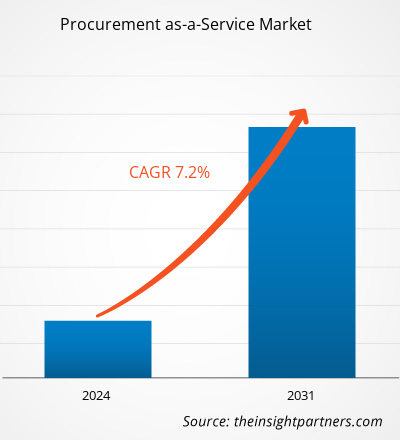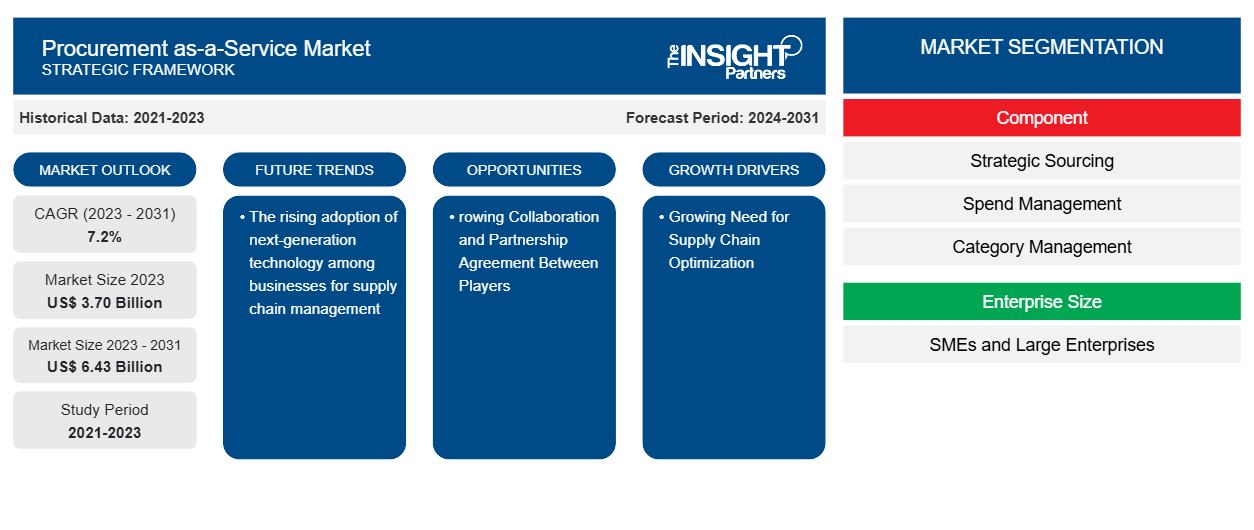Se proyecta que el tamaño del mercado de compras como servicio alcance los 6.430 millones de dólares en 2031, frente a los 3.700 millones de dólares en 2023. Se espera que el mercado registre una CAGR del 7,2 % entre 2023 y 2031. Es probable que la creciente adopción de tecnología de última generación entre las empresas para la gestión de la cadena de suministro siga siendo una tendencia clave en el mercado de compras como servicio.
Análisis del mercado de compras como servicio
El mercado de compras como servicio está creciendo a un ritmo rápido debido a la creciente necesidad de optimizar la cadena de suministro y al creciente número de actividades de importación y exportación en todo el mundo. El mercado se está expandiendo de manera constante, impulsado por las iniciativas gubernamentales para promover la digitalización con el fin de automatizar el flujo de trabajo. Además, la creciente colaboración y los acuerdos de asociación entre los actores están brindando oportunidades lucrativas para el crecimiento del mercado.
Panorama del mercado de compras como servicio
El aprovisionamiento como servicio (PaaS) es un modelo de externalización de las compras que combina recursos (personas, herramientas y conocimientos) para satisfacer los requisitos de aprovisionamiento de una organización. En la actualidad, muchas organizaciones utilizan ordenadores para gestionar todo el proceso de compra, desde la consulta inicial hasta la factura final. Además, en el aprovisionamiento digital se utilizan tecnologías disruptivas para facilitar la automatización de las transacciones. Además, permite operaciones predictivas y proactivas, como el abastecimiento estratégico y la gestión de proveedores, lo que reduce los gastos operativos de una organización. La creciente necesidad de las empresas de agilizar las operaciones de aprovisionamiento para gestionar el cumplimiento de las normativas y los contratos está impulsando el mercado.
Personalice este informe según sus necesidades
Obtendrá personalización en cualquier informe, sin cargo, incluidas partes de este informe o análisis a nivel de país, paquete de datos de Excel, así como también grandes ofertas y descuentos para empresas emergentes y universidades.
-
Obtenga las principales tendencias clave del mercado de este informe.Esta muestra GRATUITA incluirá análisis de datos, desde tendencias del mercado hasta estimaciones y pronósticos.
Factores impulsores y oportunidades del mercado de compras como servicio
Creciente necesidad de optimizar la cadena de suministro
Los administradores de la cadena de suministro adoptan ampliamente los servicios de gestión de adquisiciones para supervisar las operaciones generales de la cadena de suministro. Estos servicios permiten a los administradores de la cadena de suministro anticipar significativamente los problemas potenciales en la cadena de suministro y reasignar los recursos en consecuencia. Además, las compras como servicio pueden generar soluciones confiables basadas en datos que se utilizan para mejorar la eficiencia de los procesos comerciales. El software de gestión de adquisiciones ofrece sistemas de gestión de procesos basados en excepciones que ayudan a los usuarios a administrar operaciones de estado estable y aumentar la visibilidad multifuncional. Como resultado, los consumidores invierten cada vez más en software de gestión de adquisiciones para mantener la transparencia en la cadena de suministro, la divulgación de pedidos y datos de envío.
Colaboración creciente y acuerdos de asociación entre actores: una oportunidad en el mercado de compras como servicio
El avance tecnológico y la creciente demanda de computación en la nube , inteligencia artificial, análisis de datos y tecnología de aprendizaje automático entre los actores del mercado para mejorar sus ofertas de servicios están creando oportunidades en el mercado. Además, la creciente demanda de servicios tecnológicamente avanzados entre los consumidores alienta a los actores del mercado a desarrollar soluciones innovadoras o agregar funciones a sus carteras existentes. Por ejemplo, en noviembre de 2022, Corbus, LLC firmó un acuerdo de asociación de adquisiciones de la cadena de suministro con GIS para desarrollar soluciones únicas. Esta asociación ayuda a GIS a entregar infraestructura y recursos a clientes en Europa, América Latina, América del Norte, Asia, Medio Oriente y África.
Análisis de segmentación del informe de mercado de adquisiciones como servicio
Los segmentos clave que contribuyeron a la derivación del análisis del mercado de adquisiciones como servicio son el componente, el tamaño de la empresa y el usuario final.
- Según los componentes, el mercado se segmenta en abastecimiento estratégico, gestión de gastos, gestión de categorías, gestión de procesos, gestión de contratos y gestión de transacciones. El segmento de gestión de gastos tuvo una mayor participación de mercado en 2023.
- En términos de tamaño de las empresas, el mercado se divide en pymes y grandes empresas. El segmento de las grandes empresas tuvo una mayor participación de mercado en 2023.
- En función del usuario final, el mercado se segmenta en TI y telecomunicaciones, bienes de consumo y venta minorista, manufactura, energía y servicios públicos, atención médica, hotelería y turismo, entre otros. El segmento de manufactura tuvo la mayor participación del mercado en 2023.
Análisis de la cuota de mercado de las compras como servicio por geografía
El alcance geográfico del informe del mercado de adquisiciones como servicio se divide principalmente en cinco regiones: América del Norte, Asia Pacífico, Europa, Medio Oriente y África, y América del Sur/América del Sur y Central.
En términos de ingresos, América del Norte representó la mayor participación en el mercado de compras como servicio, debido al avance tecnológico y la integración de IA, blockchain y otras tecnologías para mejorar la cadena de suministro. La importante inversión gubernamental para promover la digitalización de las empresas está impulsando el mercado en la región. La creciente digitalización alienta a los actores del mercado a adoptar tecnologías digitales para agilizar sus procesos de compras, lo que impulsa el mercado en América del Norte.
Perspectivas regionales del mercado de compras como servicio
Los analistas de Insight Partners explicaron en detalle las tendencias y los factores regionales que influyen en el mercado de compras como servicio durante el período de pronóstico. Esta sección también analiza los segmentos y la geografía del mercado de compras como servicio en América del Norte, Europa, Asia Pacífico, Oriente Medio y África, y América del Sur y Central.

- Obtenga los datos regionales específicos para el mercado de compras como servicio
Alcance del informe de mercado de compras como servicio
| Atributo del informe | Detalles |
|---|---|
| Tamaño del mercado en 2023 | US$ 3.70 mil millones |
| Tamaño del mercado en 2031 | 6.430 millones de dólares estadounidenses |
| CAGR global (2023 - 2031) | 7,2% |
| Datos históricos | 2021-2023 |
| Período de pronóstico | 2024-2031 |
| Segmentos cubiertos |
Por componente
|
| Regiones y países cubiertos |
América del norte
|
| Líderes del mercado y perfiles de empresas clave |
|
Densidad de actores del mercado de compras como servicio: comprensión de su impacto en la dinámica empresarial
El mercado de compras como servicio está creciendo rápidamente, impulsado por la creciente demanda de los usuarios finales debido a factores como la evolución de las preferencias de los consumidores, los avances tecnológicos y una mayor conciencia de los beneficios del producto. A medida que aumenta la demanda, las empresas amplían sus ofertas, innovan para satisfacer las necesidades de los consumidores y aprovechan las tendencias emergentes, lo que impulsa aún más el crecimiento del mercado.
La densidad de actores del mercado se refiere a la distribución de las empresas o firmas que operan dentro de un mercado o industria en particular. Indica cuántos competidores (actores del mercado) están presentes en un espacio de mercado determinado en relación con su tamaño o valor total de mercado.
Las principales empresas que operan en el mercado de compras como servicio son:
- Accenture
- CAPGEMINI SE
- Corbus
- Sociedad de responsabilidad limitada
- Genpact Limitada.
- PEI
Descargo de responsabilidad : Las empresas enumeradas anteriormente no están clasificadas en ningún orden particular.

- Obtenga una descripción general de los principales actores clave del mercado de adquisiciones como servicio
Noticias y desarrollos recientes del mercado de compras como servicio
El mercado de compras como servicio se evalúa mediante la recopilación de datos cualitativos y cuantitativos a partir de investigaciones primarias y secundarias, que incluyen publicaciones corporativas importantes, datos de asociaciones y bases de datos. A continuación, se incluye una lista de los avances en el mercado de compras como servicio y las estrategias:
- En febrero de 2024, Vodafone Group Plc e International Machine Business Corp trabajarán juntos a nivel industrial y liderarán el grupo de trabajo de redes de telecomunicaciones postcuánticas de la GSMA, que apoyará a sus socios y clientes en su viaje hacia la seguridad cuántica, en particular a medida que se adopte la criptografía postcuántica en toda la cadena de suministro de telecomunicaciones global . (Fuente: Vodafone Group Plc, comunicado de prensa, 2024)
Informe sobre el mercado de adquisiciones como servicio: cobertura y resultados
El informe “Tamaño y pronóstico del mercado de adquisiciones como servicio (2021-2031)” proporciona un análisis detallado del mercado que cubre las siguientes áreas:
- Tamaño del mercado y pronóstico a nivel global, regional y nacional para todos los segmentos clave del mercado cubiertos bajo el alcance
- Dinámica del mercado, como impulsores, restricciones y oportunidades clave
- Principales tendencias futuras
- Análisis detallado de las cinco fuerzas de Porter y PEST y FODA
- Análisis del mercado global y regional que cubre las tendencias clave del mercado, los principales actores, las regulaciones y los desarrollos recientes del mercado.
- Análisis del panorama de la industria y de la competencia que abarca la concentración del mercado, el análisis de mapas de calor, los actores destacados y los desarrollos recientes
- Perfiles detallados de empresas
- Análisis histórico (2 años), año base, pronóstico (7 años) con CAGR
- Análisis PEST y FODA
- Tamaño del mercado, valor/volumen: global, regional y nacional
- Industria y panorama competitivo
- Conjunto de datos de Excel
Informes recientes
Testimonios
Razón para comprar
- Toma de decisiones informada
- Comprensión de la dinámica del mercado
- Análisis competitivo
- Información sobre clientes
- Pronósticos del mercado
- Mitigación de riesgos
- Planificación estratégica
- Justificación de la inversión
- Identificación de mercados emergentes
- Mejora de las estrategias de marketing
- Impulso de la eficiencia operativa
- Alineación con las tendencias regulatorias























 Obtenga una muestra gratuita para - Mercado de compras como servicio
Obtenga una muestra gratuita para - Mercado de compras como servicio